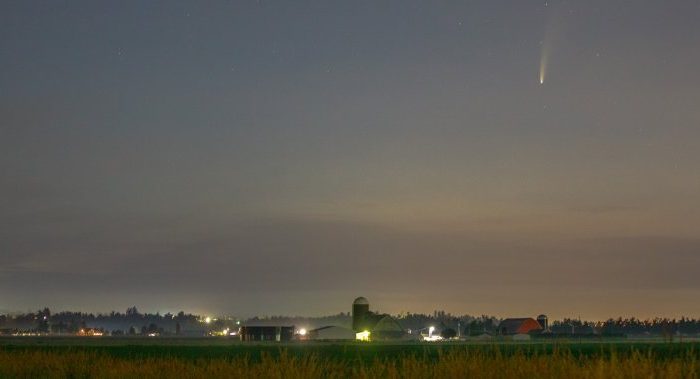A Washington state man is sharing gorgeous photos of a rare comet visible in the night sky over British Columbia this month.
Weather watcher Randy Small from Whatcom County caught sight of the comet NEOWISE over Abbotsford around 3:15 a.m., Saturday morning.
Story continues below advertisement
Astronomer Rachel Wang with Vancouver’s HR Macmillan Space Centre said NEOWISE is a rare comet, on a massive “near parabolic” orbit.
That means it only appears in Earth’s sky once every several thousand years — as compared to Haley’s Comet, whose orbit brings it into range every 75-76 years.
“It’s coming from outside of our solar system, coming in and flying by. It just made its closest approach July 3 to the sun,” she said.
“It’s going towards the closest approach to Earth around July 22, and then it will slingshot out and leave our solar system.
“So this really is a once-in-a-lifetime comet to check out.”
Read more:
How to see the ‘once a decade’ comet NEOWISE in Canada
Story continues below advertisement
Comet NEOWISE is named for the NEOWISE spacecraft that discovered it in March.
Wang says NEOWISE is currently visible in the pre-dawn morning by looking northeast, but that as it gets closer to Earth, it will become visible after dusk in the northwest.
She said it’s currently visible in the constellation Auriga, which can be found by tracking the star Capella — the second brightest star in the night sky.
Comet NEOWISE from ISS, July 5th pic.twitter.com/pAbGdtchAc
— Seán Doran (@_TheSeaning) July 7, 2020
“When I went out last night, I was actually able to see it with my naked eye by looking at the comet and looking slightly to the right or left of it, using my peripheral vision,” she said.
Story continues below advertisement
“Of course, a pair of binoculars makes everything a lot easier, and using long exposure on a camera can up the brightness a little bit.”
Ironically, Wang says the comet will become less bright the closer it gets to earth, meaning interested stargazers will want to get out sooner rather than later to catch a glimpse.
Comets are balls of icy gas and dust, or “dirty snowballs,” explains Wang. Their distinctive visible tails are caused as bits of the comet break off and are left in their wake.
© 2020 Global News, a division of Corus Entertainment Inc.read more
Rare comet currently visible in night sky over British Columbia – Globalnews.ca


